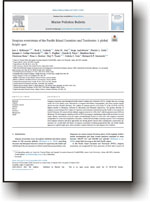Solomon Islands
The Solomon Islands is the third largest archipelago in the South Pacific, comprising a total of 992 islands, with scattered in a chain in a south-easterly direction from Papua New Guinea. The bulk of the land area comprises seven large volcanic islands which form a double chain running from northwest to southwest and converging on the island of Makira. The Santa Crus Islands (Temotu Province) are a second group of three larger volcanic islands lying to the east, and separated from the main archipelago of the country by the 6000m deep Torres Trench.
The coastal marine ecosystem of the Solomon Islands includes wide areas still largely unimpacted by human activities, although there are also areas where such pressures are large and increasing. The islands have one of the fastest population growth rates in the world, and 86 percent of the people are rural. Dependence on coastal marine ecosystems for protein remains high and subsistence fishing is widespread.
Southeasterly trade winds (Ara) blow from May through to October and the northwesterly monsoon winds (Koburu) blow from December until March.
Coral reefs are mainly fringing and intermittent around all of the islands. Seagrass meadows are a significant coastal habitat of the Solomon Islands Seagrasses are a functional grouping referring to vascular flowering plants, which grow fully submerged and rooted in soft bottom estuarine and marine environments. In the Solomon Islands, they are found in habitats extending from the intertidal to subtidal, along mangrove coastlines, estuaries, shallow embayments, as well as coral-reef, inter-reef and offshore island situations.
Seagrass-Watch in Solomon Islands
To provide an early warning of change, long-term monitoring has been established in Solomon Islands as part of the Seagrass-Watch, Global Seagrass Observing Network (www.seagrasswatch.org). Establishing a network of monitoring sites in Solomon Islands provides valuable information on temporal trends in the health status of seagrass meadows in the region and provides a tool for decision-makers in adopting protective measures. It encourages local communities to become involved in seagrass management and protection. Working with both scientists and local stakeholders, this approach is designed to draw attention to the many local anthropogenic impacts on seagrass meadows which degrade coastal ecosystems and decrease their yield of natural resources
 | McKenzie, L.J., Yoshida, R.L., Aini, J.W., Andréfouet, S., Colin, P.L., Cullen-Unsworth, L.C., Hughes, A.T., Payri, C.E., Rota, M., Shaw, C., Tsuda, R.T., Vuki, V.C. and Unsworth, R.K.F. (2021). Seagrass ecosystems of the Pacific Island Countries and Territories: a global bright spot. Marine Pollution Bulletin 167, 112308. doi.org/10.1016/j.marpolbul.2021.112308 |
|---|
Location
Tetepare Island
Monitoring: archived
Location: Tetepare Island, Western Province
Site code: TT1, TT2, TT3
Comments: Tetepare Island (in the Western Province ) is the largest uninhabited island in the South Pacific.
Location
Ravata Point
Monitoring: archived
Location: Rendova Island, Western Province
Site code: RN1, RN2